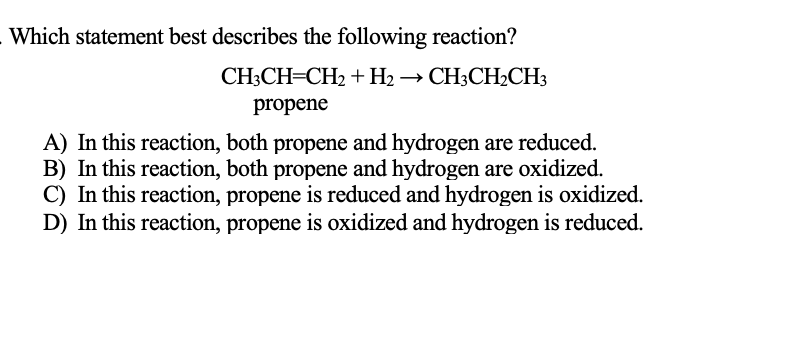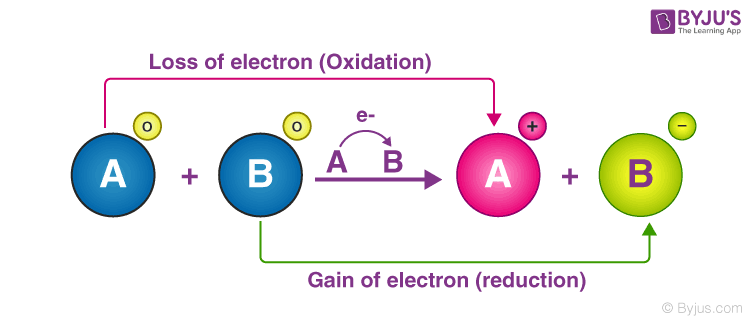O If there is no change in the oxidation states of atoms from reactants to products the reaction is an oxidation- reduction reaction. Or simply redox reactions.

Solved What Will Happen If Ammonium Is Added To The Solution Chegg Com
Oxidation is loss Reduction is gain.

. Which of the following statements about oxidation-reduction reactions is FALSE. The hydrogen atom lost an electron. The oxidation state of carbon increases from 2 to 4 while the oxidation state of the hydrogen decreases from 1 to 0.
Reduction results in an increase in the number of C - Z bonds. The electronic equation that represents the oxidation reaction that occurs is A HCl KOH KCl H2O B4 HCl MnO2 MnCl2 2 H2O Cl2 C 2 HCl CaCO3 CaCl2 H2O CO2 D 2 HCl FeS FeCl2 H2S 21Which equation represents an oxidation-reduction reaction. Two ferrous Fe2 cytochrome c molecules donate electrons to fully reduce O2 to one molecule of H20 Two ferric Fe3 cytochrome c molecules donate electrons to fully reduce O2 to one molecule of.
As such electron-transfer reactions are also called oxidation-reduction reactions. Another term for an oxidation-reduction reaction. The answer is Oxidation and reduction occur simultaneously because oxidation and reduction are recognized as interdependent because one cant occur without other.
Please select all of the following which are functions of carbohydrates. O If there is formation of salt and water the reaction is an oxidation-reduction reaction. 3 Oxidation occurs after reduction.
But when an element is reduced it gains electrons. The silver atom gained an electron. A chemical reaction in which electrons are transferred between reactants.
Reduction is the gain of electrons. 1 pts Question 25 Which of the following statements best describes the oxidation-reduction reaction catalyzed by cytrochrome c oxidase Complex IV. Also called a redox reaction.
AMg 2 HCl MgCl2 H2 B MgOH2 2 HCl MgCl2 2 H2O. 1Which statement best describes an oxidation-reduction reaction. In this case both Bi and Mn are already balanced.
The conversion of an alkene to an alkane is reduction. I biological metabolism of FeII and nitrate in which FeII is enzymatically oxidized by c-Cyts in the EPSs or outer membrane enzymatic reactions and ii FeII oxidation by biogenic nitrite in which nitrate is first reduced to nitrite by strain BoFeN1 or strain 2002. Oxidation is the loss of electrons during a reaction by a molecule atom or ion.
The type of reaction that is shown is. Two possible pathways of nitrate reduction coupled with FeII oxidation are proposed. The process by which a molecule loses electrons and decreases in energy is called oxidation.
If there is formation of a precipitate the reaction is an oxidation-reduction reaction. H went from 0 in H 2 g to 1 in H aq. A chemical reaction in which electrons are transferred between reactants.
Oxygen is removed from carbon dioxide. H 2 S is oxidized to sulfur. The full or partial loss of electrons or the gain of oxygen.
B Electrochemistry is the study of only reduction reactions. An equation that shows either the oxidation or the reduction reaction that occurs during a redox reaction. A Redox reaction oxidation-reduction reaction involves the exchangetransfer.
A Oxidation and reduction half-reactions occur at electrodes in electrochemical cells. E All voltaic galvanic cells involve the use of electricity to initiate nonspontaneous chemical reactions. SO 2 H 2 S S H 2 O reaction.
This is a redox reaction oxidation reduction. The correct statement that describes a Redox reaction is D. The chemical formula that shows the correct subscripts is D BeF₂ 3.
When an element is oxidized it loses electrons. 2 Oxidation occurs before reduction. Which of the following statements refers to an oxidation process.
C decomposition reaction. The process by which a molecule gains electrons and increases in energy is called reduction. The conversion of an alkyne to an alkene is reduction.
The opposite process is called reduction which occurs when there is a gain of electrons or the oxidation state of an atom molecule or ion decreases. Balance both reactions for all elements except oxygen and hydrogen. Oxidation occurs when the oxidation number of an atom becomes larger.
O If there is formation of a precipitate the reaction is an oxidation-reduction reaction. 6HBiO 3 Bi33H2O 6 H BiO 3 Bi 3 3 H 2 O Bi goes from a 5 to a 3 Oxidation. A reaction that involves the full or partial transfer of electrons from one reactant to another.
Because electrons are neither created nor destroyed in a chemical reaction oxidation and reduction always occur in pairs it is impossible to have one without the other. A chemical reaction in which electrons are released from the system. Which of the following statements is FALSE.
D Oxidation occurs at the anode. Mn2 MnO 4 Mn 2 MnO 4 Mn goes from a 2 to a 5 Step 2. Reduction occurs when the oxidation number of an atom becomes smaller.
Oxidation involves the loss of electrons and reduction involves the gain of electrons. This reaction occurs in the presence of moisture. Oxidation and reduction are therefore best defined as follows.
C Reduction occurs at the cathode. Oxidation and Reduction reactions are always interlinked. Oxidation occurs at the anode of an electrochemical cell.
Sulphur atom in the sulphur dioxide molecule is reduced to sulfur while sulphur atom in the hydrogen sulphide is oxidized to sulfur. B All electrochemical reactions involve the transfer of electrons. O O O If there is a change in the oxidation states of atorns from reactants to products the reaction is an oxidation- reduction reaction If there is formation of salt and water the reaction is an oxidation-reduction reaction.
The chemical formula that shows the correct subscripts is D BeF₂. Oxidation results in a decrease in the number of C - H bonds. This is the basis of redox reactions.
Hydrogen is added to ethene. C decomposition reaction. 4 Oxidation occurs but reduction does not.
Oxidation and reduction occur simultaneosly. The type of reaction that is shown is. Oxidation is the loss of electrons.
However an oxidizing agent oxidizes something else and gets reduced therefore gaining electrons. Ag went from 1 in AgCl s to 0 in Ag s. The correct statement that describes a Redox reaction is D.
Cl kept its oxidation state constant at -1 throughout the reaction. Oxidation occurs when the oxidation state of a molecule atom or ion is increased. A chemical reaction in which electrons are transferred from one atom to another.
The atom that loses electrons is oxidized and the atom that gains electrons is reduced.

Mcb Exam 3 Sapling Questions Flashcards Quizlet

Mastering Microbiology Ch 5 Flashcards Quizlet


0 Comments